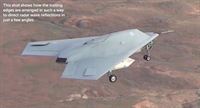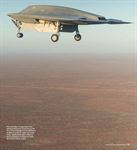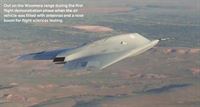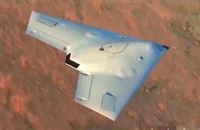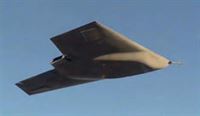Фотографии
-
Регистрационный номер: ZZ250 [10] Taranis ZZ250 airborne over the Woomera test range in South Australia.
Antennas fitted to the air vehicle’s fuselage underside for flight sciences testing appear to be positioned within under fuselage panels.Самолёты на фотографии: BAe Taranis - Великобритания - 2013
-
Регистрационный номер: ZZ250 [10] Note how the curved form of the upper fuselage meets the leading edge of the engine intake at an apex.
Самолёты на фотографии: BAe Taranis - Великобритания - 2013
-
Регистрационный номер: ZZ250 [10] This head-on shot shows how BAE Systems blackened the air vehicle's air intake to prevent visual acquisition of its internal form.
Самолёты на фотографии: BAe Taranis - Великобритания - 2013
-
Регистрационный номер: ZZ250 [10] Main landing gear doors open toward the aircraft centreline rather than toward the wing tip as is the case with the American B-2 bomber and the X-47B unmanned combat air system demonstrator.
Самолёты на фотографии: BAe Taranis - Великобритания - 2013
-
Регистрационный номер: ZZ250 [10] Great top-down view of the Taranis air vehicle shows the curved configuration of the upper fuselage surfaces, the edge treatments of the wing and control surfaces, the fuselage forward of the intake, and the narrow engine exhaust positioned on the upper surface.
Самолёты на фотографии: BAe Taranis - Великобритания - 2013
-
Регистрационный номер: ZZ250 [10] This shot shows how the trailing edges are arranged in such a way to direct radar wave reflections in just a few angles.
Самолёты на фотографии: BAe Taranis - Великобритания - 2013
-
Регистрационный номер: ZZ250 [10] This shot taken on approach to the airfield at Woomera shows the curved form of the fuselage and the difference in depth between its upper and lower forms. Depth of the upper surface is such to house an S-shaped air intake duct and an Adour engine.
Самолёты на фотографии: BAe Taranis - Великобритания - 2013
-
Регистрационный номер: ZZ250 [10] Out on the Woomera range during the first flight demonstration phase when the air vehicle was fitted with antennas and a nose boom for flight sciences testing.
Самолёты на фотографии: BAe Taranis - Великобритания - 2013
-
Регистрационный номер: ZZ250 [10] Taranis is shaped to achieve specular scattering of radar waves such that they bounce off the structure; the fuselage shape and articulation is formed to minimise the returns to a radar.
Самолёты на фотографии: BAe Taranis - Великобритания - 2013
-
Регистрационный номер: ZZ250 [10] The fuselage underside resembles the hull of a boat. The lower surface is gently curved and meets the upper surface at an acute angle to limit the angles of specular reflections.
Самолёты на фотографии: BAe Taranis - Великобритания - 2013
Статьи
- -
- Airscene
- Backpages
- News by countries
- ??? - Advanced Hawkeye /Military/
- ??? - Syria Tornado's last call /Military/ (2)
- B.Taghvaee - Iranian air exercise /Military/
- K.Wills, I.Harding - Clockwork /Military/
- M.Ayton - Made in England: Taranis /Technology/
- N.Pittaway - Combat Proven - Australia's eyes in the sky /Military/
- P.Butowski - Early warning, Russian style /Military/
- R.Niccoli - Dynamic Manta /Military/





